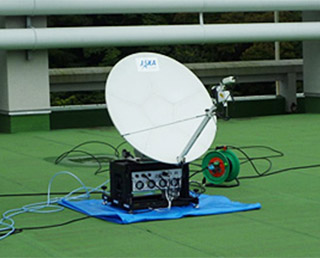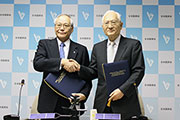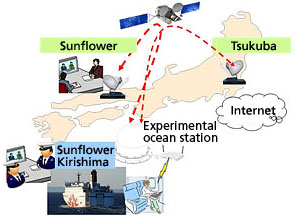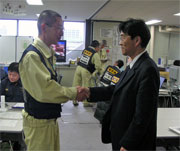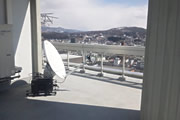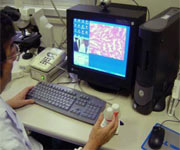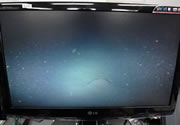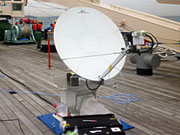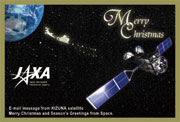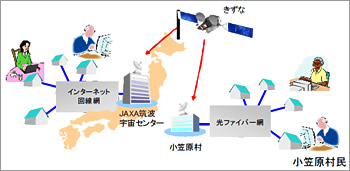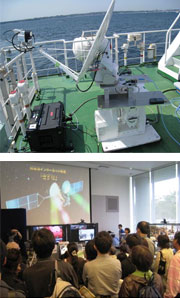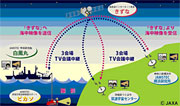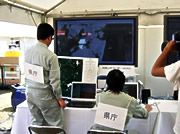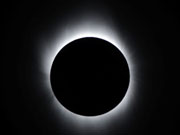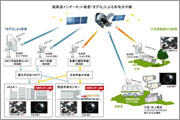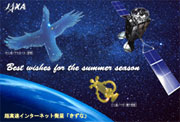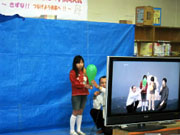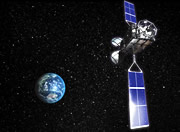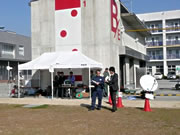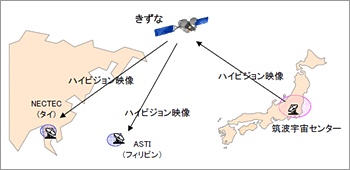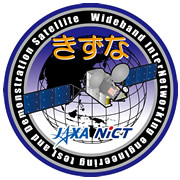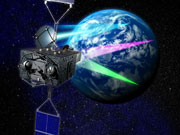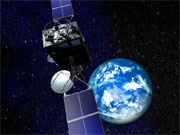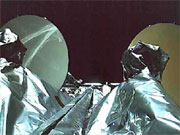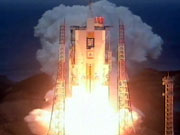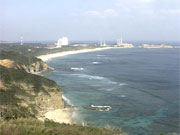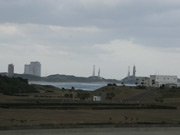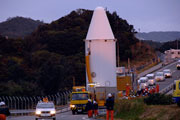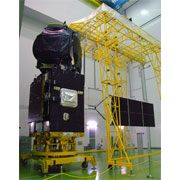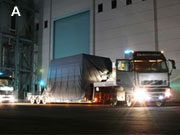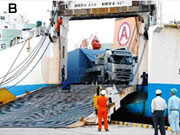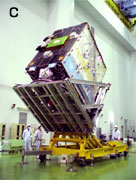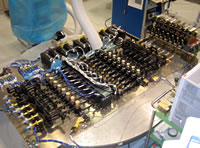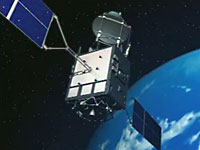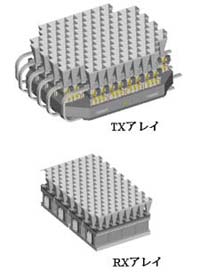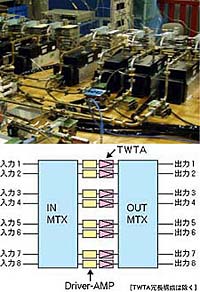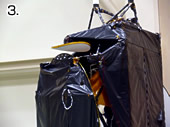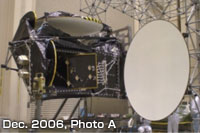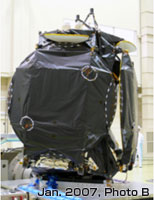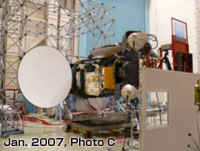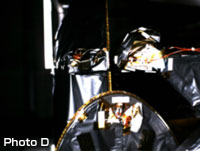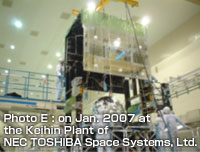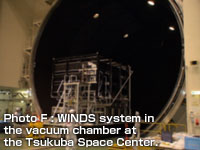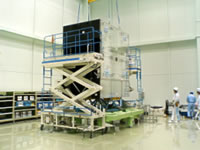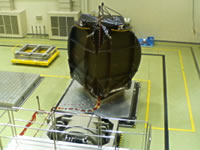Jul. 29, 2015 Updated
Communication establishment training with satellites using KIZUNA in a prediction of the Nankai Trough earthquake
On July 29, 2015, JAXA and NICT offered the Internet environment with asatellite when the Japan Medical Association (JMA) conducted the “satellite use demonstration in a prediction of the Nankai Trough earthquake (Disaster preparation drill) 2015.” The communication environment was established by setting up a ground station in each JMA prefectural office under the assumption that communication lines were cut off due to a large-scale disaster.
We transmitted high-definition images from a small mobile station on a NICT car via the KIZUNA and shared information with a virtual disaster-stricken area using the "Disaster Relief Aircraft Information Sharing Network (D- NET).”
Image: Mobile VSAT (in Kochi prefectural office.)
|
|
Jan. 30, 2013 Updated
Agreement signed with JMA on demonstration supporting disaster medicine
JAXA and the Japan Medical Association (JMA) signed an agreement to jointly conduct application experiments of the Wideband Internetworking Engineering Test and Demonstration satellite “KIZUNA” to support disaster medicine, after JAXA and JMA studied the utilization method of the KIZUNA in support activities and measures at the time of a large-scale disaster.
For disaster medicine support activities, it is imperative to understand the actual conditions of shelters, and the sick and wounded at a disaster-stricken area, then to share such information with all parties concerned. In the case of a large-scale disaster, the usual communication environment may be in total chaos.
In July, 2012, JMA and JAXA held demonstrations with scenarios of a huge earthquake. As a result, the agreement this time was signed aiming at establishing a more useful information sharing method at the time of disaster via the Internet satellite under the common recognition of supporting as many disaster-stricken people as possible. We will further work hard to provide helpful support at the time of a large-scale disaster.
|
|
Dec. 1, 2011 Updated
Merry Christmas from Space! Message to be sent using KIZUNA
JAXA is offering a Christmas greeting mail service using the KIZUNA’s network this year again. The purpose of this event is to deepen your understanding of the wideband internetworking engineering test and demonstration satellite “KIZUNA.”
On Christmas eve, Dec. 24, a message will be sent from space via the KIZUNA, which is flying on a geostationary orbit at an altitude of 36,000 km. You can convey your feelings to your loved ones from space. Why don’t you mail your appreciation to your family, friends and sweethearts on this occasion?
| Registration: |
December 1 (Thu) thru 21 (Wed) (till 5:00 p.m. on the 21st, Japan Standard Time) 2011 |
|---|
| Message delivery: |
Dec. 24 (Sat.) 2011 (JST) |
|---|
|
|
May 27, 2011 Updated
Broadband communication verification between KIZUNA and ocean surface
JAXA and Ferry Sunflower Limited verified the functions, performance and usefulness of an experimental ocean station that was set up on a passenger liner for the Wideband Internetworking Engineering Test and Demonstration Satellite “KIZUNA.”
During the verification, we have confirmed stable high-speed communications with a sailing boat in a changing environment including fluctuating wave heights and weather conditions as well as navigating directions, thus we were able to verify that high-definition and high-quality tele-conference services and use of the Internet were possible between the onboard crew and ground staff. Use of the broadband Internet on the ocean is expected to be popularized in the future.
|
|
May 16, 2011 Updated
KIZUNA ends support for disaster measures
JAXA constructed a broadband environment using the Wideband InterNetworking engineering test and Demonstration Satellite “KIZUNA” (WINDS) between the Iwate Prefectural Office and Kamaishi city as well as Ohfunato city in an effort to support disaster measures after the Great East Japan Earthquake. The environment has enabled information dispatching and gathering via the Internet and teleconferences with high definition TV. As ground communication infrastructure has recently been restored, we completed our provision of communication lines according to the Iwate government’s request.
KIZUNA’s support activities in the aftermath of the gigantic earthquake are now completed, but we continue to wish for the further recovery of the disaster-stricken areas from the bottom of our hearts.
|
|
Mar. 20, 2011 Updated
Communication line starts using KIZUNA to support areas hit by earthquake
JAXA has established the broadband environment using the wideband Internetworking Engineering Test and Demonstration Satellite "KIZUNA" (WINDS) as support for disaster measures for areas stricken by the Tohoku Region Pacific Ocean Coastal Earthquake.
With this support, high definition teleconference systems, IP telephones, radio LAN and other means became available to share and dispatch disaster information.
Photo: Ground antenna (movable VSAT) installed at the Iwate Prefectural Office (Antenna diameter 1.0 m)
|
|
Mar. 17, 2011 Updated
KIZUNA supports disaster relief measures after Tohoku Region Pacific Ocean Coastal Earthquake
On March 17, JAXA dispatched two sets of movable ground antennas, two teleconference systems, four radio LANs and other equipment for the Wideband Internetworking Engineering Test and Demonstration Satellite "KIZUNA" with five personnel necessary for setting up and operating communication systems to Iwate Prefecture, which has been severely damaged by the Tohoku Regional Pacific Ocean Coastal Earthquake. The dispatch this time was based on a request by the Ministry of Education, Culture, Sports, Science and Technology, who received a petition from Iwate Prefecture. The support activity is part of KIZUNA's experimental utilization.
The Iwate Prefecture disaster measurement headquarters will use the KIZUNA for communications between the headquarters and the disaster-stricken areas (Kamaishi City), where all communication means including fixed-line telephones and mobile phones have been severed.
Once the communication system using the KIZUNA has been set up, information can be shared through the high definition teleconference system and the IP telephone, thus people's safety information can also be sent and received.
Photo : The ground antenna (movable VSAT, the antenna is 1.0 meter in radius)
|
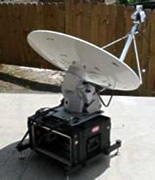 |
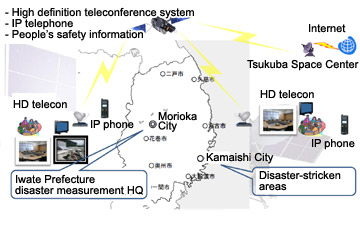 |
| Conceptual diagram of the communication system to be installed |
|
Dec. 27, 2010 Updated
Have you received a "Merry Christmas from space" message?
We were successfully able to send 88,426 Christmas messages, which we had been asked to send on Dec. 24 through the Wideband Internetworking Engineering Test and Demonstration Satellite "KIZUNA." We hope your loved one received your message.
* Due to errors with addresses and filters, some message might not have been received.
|
|
Dec. 3, 2010 Updated
Holiday greetings from Space 2010
JAXA is offering a chance to send a holiday message from space again this year in order to facilitate people’s understanding of the Wideband InterNetworking engineering test and Demonstration Satellite "KIZUNA.” Your message will be transmitted through the "KIZUNA," which flies at an altitude of about 36,000 km, on December 24.
It is a rare opportunity to convey your true feeling to your loved ones from space. Why don't you send a message from space?
We will accept your message between December 3 (Fri.) and 22 (Wed., until 5:00 p.m. on the last day, all time and dates are Japan Standard Time.) The messages will be delivered on Dec. 24 (Fri.)
|
|
Oct. 20, 2010 Updated
Remote training experiment using KIZUNA
On Oct. 5, JAXA conducted the first remote training experiment using the KIZUNA in cooperation with the Statistical Institute for Asia and the Pacific (SIAP.)
International cooperation is important for statistical administration, thus the SIAP considers that remote seminars and training concerning statistical survey methods in Pacific countries and regions via the KIZUNA are an efficient way to train many specialists. For this experimental training session, a JAXA ground station at the University of Tsukuba and another JAXA ground station at the National Electronics and Computer Technology Center (NECTEC) were connected through the KIZUNA, then the NECTEC and the Asian Institute of Technology (AIT) were linked via a ground line to perform training in a classroom at the University of Tsukuba and in a classroom at the AIT via a videoconference system. As we were able to send very clear voice and image data, we contributed to improving the statistical survey capability of Thai government staff through the remote training by SIAP lecturers stationed at the University of Tsukuba.
|
|
Oct. 7, 2010 Updated
KIZUNA high resolution image transmission
Setting up ground stations in Sentinel Asia member countries
JAXA has been engaging in various verification experiments using the Wideband Internetworking Engineering Test and Demonstration Satellite “KIZUNA.” Among them, we carried out real-time transmission verification via the KIZUNA as part of the trial application for remote medicine with the National Institution of Information and Communications Technology (NICT.) We sent three-dimensional images (4K: four times of high vision resolution) of cardiac surgery.
We have also begun setting up ground stations for the KIZUNA in Sentinel Asia member countries. With those ground stations, we will be able to transmit observation data of disaster stricken areas acquired by the DAICHI at high speed.
|
|
Aug. 18, 2010 Updated
KIZUNA: Successful high-speed communications with a navigating vessel
JAXA and the Japan Agency for Marine-Earth Science and Technology (JAMSTEC) successfully carried out real-time transmission of high-definition images of the deep ocean taken by the next generation deep-ocean autonomous underwater vehicle "MR-X1" using the Wideband Internetworking Engineering Test and Demonstration Satellite "KIZUNA"via the Research Vessel "KAIYO," which was under navigation. The images were then sent to the Tsukuba Space Center in real time, and the communication speed was more than 10 times faster than the conventional marine communication service in the Asia-Pacific region.
|
|
Jan. 29, 2010 Updated
--Cutting-edge Technology-- St. Valentine's Day from Space
Send a St. Valentine's Day card from space using "KIZUNA" satellite
JAXA is holding a mail delivery experiment by further taking advantage of the super high-speed and large volume communication performance of the Wideband InterNetworking engineering test and Demonstration Satellite "KIZUNA" (WINDS) in collaboration with a cloud computing system of SOFTBANK Telecom Corp.
On Feb. 14 (Sun.), St. Valentine's Day, the KIZUNA, which if flying at an altitude of about 36,000 km, will send your love message on your behalf. Male senders are welcomed. We are accepting your registration up to 9:00 a.m. on February 12 (Fri., Japan Standard Time.) You can also make an entry through the JAXA mobile website. The KIZUNA will make your St. Valentine’s Day unique this year.
|
|
Jan. 7, 2010 Updated
KIZUNA International Symposium -- Asia-Pacific Area Linked by KIZUNA --
Since its launch two years ago, “KIZUNA” has been conducting various demonstrations for establishing satellite communication technology including a live relay of high definition images of a total sun eclipse and a real-time relay of high definition images of the deep ocean sent from a vessel.
JAXA would like to hold an international symposium to report our demonstration achievements and to discuss proposals and expectations for future KIZUNA use by inviting demonstration participants from the Asia-Pacific region, which is KIZUNA’s communication area. The public is also welcomed to join us at the symposium.
Date and Time: 10:30 a.m. to 5:30p.m. on February 4 (Thu), 2010
Location: Science Museum
|
|
Dec. 25, 2009 Updated
Have you received a "Merry Christmas from space" message?
We were successfully able to send 79,280 Christmas messages, which we had been asked to send on Dec. 24 through the Wideband Internetworking Engineering Test and Demonstration Satellite "KIZUNA." We hope your loved one received your message.
* Due to errors with addresses and filters, some message might not have been received.
|
|
Nov. 27, 2009 Updated
Holiday greetings from space
-- Send a message to your loved ones through KIZUNA --
JAXA is offering a chance to send a holiday message from space again this year as it was very popular last year. You message will be transmitted through the Wideband InterNetworking engineering test and Demonstration Satellite "KIZUNA," which flies at an altitude of about 36,000 km, on December 24.
We will accept your message by 5:00 p.m. on December 18 (Fri., Japan Standard Time.) You can also register through the JAXA mobile site. Why don't you send a message to a loved one from space?
|
|
Nov. 2, 2009 Updated
Demonstration for the first practical use of broadband Internet via KIZUNA in Ogasawara
Between Nov. 15 and 24, a broadband Internet communication test using the Wideband InterNetworking engineering test and Demonstration Satellite "KIZUNA" will be held for residents in Ogasawara village, a digitally divided area.
Currently telephone and Internet communication between Ogasawara village and the main land rely on a commercial satellite, and their transmission speed is about 2 Mbps for upstream and about 10 Mbps for downstream. Using the KIZUNA, the speed will be increased to 155 Mbps for both ways. JAXA would like to verify the operability of the KIZUNA experiment system by providing the KIZUNA broadband Internet environment to Ogasawara villagers and asking them to evaluate its convenience.
|
|
Oct. 20, 2009 Updated
Successful live relay of images taken under ocean via KIZUNA to TKSC
JAXA and the Japan Agency for Maritime-Earth Science and Technology (JAMSTEC) carried out a real-time image data relay experiment transmitted from a vessel in the ocean to the JAXA Tsukuba Space Center (TKSC) via the Wideband InterNetworking engineering test and Demonstration Satellite "KIZUNA" on Oct. 16 and 17. The images under the ocean were taken by the "PICASSO," a small unmanned submersible developed for research on the ecosystem under the deep sea, and the research vessel "HAKUHO" relayed the images to the KIZUNA. The live relay was successfully performed. On the 17th, a "remote ocean class" was held via an interactive teleconference relay system by connecting the HAKUHO, JAXATKSC and JAMSTEC Yokohama Institute for Earth Science. Participants actively asked questions from each site while being surprised and fascinated by the live relay class from the vessel. Through this experiment, we were able to suggest a new future possibility that not only researchers on a vessel but also those who are in a research laboratory on the ground can participate in deep ocean investigations by using a communication satellite that can conduct bidirectional and high-speed relays of high definition images like the KIZUNA.
(Above photo: KIZUNA's small antenna and a stabilization table, Bottom photo: Open-to-public experiment at the JAXA TKSC)
|
|
Oct. 13, 2009 Updated
Live relay of images taken under ocean via KIZUNA to TKSC
JAXA and the Japan Agency for Maritime-Earth Science and Technology (JAMSTEC) will carry out a real-time image data relay experiment transmitted from a vessel in the ocean using the Wideband InterNetwarking engineering test and Demonstration Satellite “KIZUNA.” The images under the ocean will be taken by the “PICASSO,” a small unmanned submersible developed for research on the ecosystem under the deep sea, and the research vessel “HAKUHO” will relay the images to the KIZUNA. Then the satellite will send them to the Tsukuba Space Center (TKSC.) You can take a look at the images at the TKSC open house on the 17th (Sat.) Please come and have a look.
|
|
Sep. 7, 2009 Updated
Emergency communication transmission test using KIZUNA
JAXA and the Local Authorities Satellite Communications Organization (LASCOM) participated in the JFY 2009 disaster preparation drill held by Wakayama Prefecture on Sep. 6 (Sun.) 2009. During the drill, the movable satellite communication antenna (the movable ground station) of the Wideband Internetworking Engineering Test and Demonstration Satellite “KIZUNA” was used for large volume data transmission of high resolution images such as image data acquired by the Advanced Land Observing Satellite “DAICHI” and other high definition images. Through the drill, large volume data transmission via satellite communication at the time of a disaster was proved effective.
|
|
Jul. 22, 2009 Updated
KIZUNA transmitted images of total solar eclipse from Iwo Jima and Chichi Jima
A total solar eclipse was observed from Japan on July 22 for the first time in 46 years. The National Astronomical Observatory of Japan (NAOJ), NHK (Japan Broadcasting Corporation,) the National Institute of Information and Communications Technology (NICT,) and JAXA carried out the transmission experiment of high definition images of the total solar eclipse from Iwo Jima and Chichi Jima islands using the Wideband Internetworking Engineering Test and Demonstration Satellite "KIZUNA."
(Images: taken by NAOJ, transmission supported by NICT/JAXA)
|
|
Jul. 15, 2009 Updated
"KIZUNA" will transmit images of total solar eclipse from Iwo Jima and Chichi Jima Islands JAXA will also hold a screening event
On Wednesday, July 22nd, a total solar eclipse can be observed in Japan for the first time in 46 years. On this occasion, we will perform a high-definition image transmission experiment utilizing the ultra-high speed Internet satellite, "KIZUNA" (WINDS) from Iwo Jima and Chichi Jima Islands.
JAXA will host screening events to show the images from "KIZUNA" at our information center, JAXAi, and at the Tsukuba Space Center from 10:30 am on July 22. We are looking forward to you visiting these venues.
The Internet program "Space Education TV" presented by JAXA Space Education Center will also introduce an exchange event linked between Ogasawara Village and "KIZUNA" as well as photos of "sunbeams streaming through leaves" sent from the public.
* Please understand that there may be a problem with a total solar eclipse observation itself depending on the weather conditions on the day.
|
|
Jul. 8, 2009 Updated
Messages were successfully sent from space on Star Festival Day
JAXA conducted an experiment by sending a multiple amount of e-mail messages simultaneously by utilizing the KIZUNA’s large-volume transmission capacity on July 7, Star Festival Day. We successfully transmitted about 31,700 mail messages that were previously registered by readers.
Through this experiment, we were able to verify that the KIZUNA can transmit a large number of small-volume files, like e-mail, simultaneously. Therefore it can efficiently transmit data while saving time.
(* There may be some messages that were not successfully received due to address errors or filters on the receiving side.)
|
|
Jun. 11, 2009 Updated
Message from space on Tanabata
July 7 is "Tanabata," or the Star Festival when the "Weaver Star (Vega,or Orihime)" and the "Cowherd Star (Altair, or Hikoboshi)" meet once a year. This is a good opportunity to send a message from space.
Through our Wideband Internetworking Engineering Test and Demonstration Satellite "KIZUNA" flying at an altitude of 36,000 km, we will send your message to someone you would like to convey your feelings to.
You can register for the service till 5:00 p.m. on July 1 (Wed., Japan Standard Time.)
|
|
Jan. 28, 2009 Updated
Remote education experiment using a hyper mirror system
JAXA and Osaka University jointly carried out the first remote learning experiment (e-learning class) using the JAXA satellite "KIZUNA."
We set up JAXA's mobile earth station and a hyper mirror system* belonging to Osaka University in two elementary schools, Takei elementary school in the city of Usa, Oita Prefecture, and Kuhodera elementary school in the city of Yao, Osaka Prefecture, to transmit high definition images of the class rooms in the two schools. Then a class was held together at the two schools and the image of one school was sent to the other. In addition the images of two schools were synthetically composed into one image by the hyper mirror system so that the class was progressing in an environment where students in two schools look like they are studying in one class room.
Through the experiment, we were able to verify that the KIZUNA was useful for large volume, real time interactive communications that are imperative for remote education.
Also, combined with the hyper mirror system on the ground, we were able to provide more real and live visual effects with higher pixel high definition images (with a band width of 8 Mbps) which are much clearer than images transmitted through conventional ground lines (with a band width of 384kbps.)
* Hyper mirror system
A system to electrically create a new environment (like a world in a mirror) for conversation. Unlike conventional conversation, the system enables all participants to feel that they are talking at the same place through synthetic images.
|
|
Dec. 25, 2008 Updated
Have you received a "Merry Christmas from space" message?
We were successfully able to send 79,240 Christmas messages, which we had been asked to send on Dec. 24 through the Wideband Internetworking Engineering Test and Demonstration Satellite "KIZUNA."
Through this Christmas message experiment, we were able to verify that the KIZUNA's communication system can be seamlessly connected with the ground Internet for e-mail.
* Due to errors with addresses and filters, some message might not have been received.
|
|
Nov. 21, 2008 Updated
KIZUNA selected as the "Best of what's new 2008" by "Popular Science"
The Wideband Internetworking Engineering Test and Demonstration Satellite "KIZUNA" was selected as the "Best of what's new 2008" by the American Magazine "Popular Science." The reasons for the decision were that the magazine highly evaluated the provision of KIZUNA's highest speed satellite Internet communications (1.2 Gbps, which is about 500 times faster than the average American domestic speed,) which can be received by a less expensive small antenna, in remote areas in Japan and south-east Asia, and its function to change the signal strength according to the weather conditions of a specific region by tracking the weather in that area.
|
|
Nov. 17, 2008 Updated
KIZUNA emergency communication transmission experiment in Shikoku
JAXA and the Local Authorities Satellite Communications Organization (LASCOM) participated in a Shikoku regional emergency communication drill on Nov. 14 (Fri.) 2008. In the drill, we carried out a basic experiment using the portable ground station of the Wideband Internetworking Engineering Test and Demonstration Satellite "KIZUNA" for transmitting high precision images to verify the validity of satellite communications in times of disaster.
|
|
Nov. 10, 2008 Updated
Overseas multicast experiment using "KIZUNA"
Between Nov. 5 and 7, 2008, a multicast experiment with overseas ground stations (sending data to pre-designated multiple places at the same time) was held using the Wideband Internetworking Engineering Test and Demonstration Satellite "KIZUNA." We confirmed that multicast transmissions were successfully performed. By using KIZUNA's high speed data transmission, high definition images of the moon's surface and the earth taken by the onboard High Definition TV camera of the lunar explorer "KAGUYA" was multicast to the NECTEC (National Electronics and Computer Technology Center of Thailand) and the ASTI (Advanced Science and Technology Institute of the Philippines) to introduce JAXA's space development activities to those taking part in the experiment overseas.
|
|
Jul. 9, 2008 Updated
KIZUNA moved to regular operation phase
JAXA has been carrying out the initial functional verification of the onboard equipment of the "KIZUNA" in cooperation with the National Institute of Information and Communications Technology for about three and half months since the KIZUNA was injected into its scheduled geostationary orbit (East longitude of about 143 degrees) on March 14, 2008. After we confirmed that all functions were normal, we completed the checks on all the equipment on June 27. On June 30, a review was held to determine if we should move onto the regular operation phase, and we decided to shift from the initial phase to the regular operation phase.
For the next three months, we will carry out various tests to provide trial users with a stable environment for their experiments. We will then gradually increase the opportunities for actual experiments.
|
|
May 12, 2008 Updated
"KIZUNA" Carries out World's Fastest Satellite Data Communication at Speed of 1.2 Gbps
On May 2, JAXA and the National Institute of Information and Communications Technology (NICT) successfully carried out super high-speed data communication at a speed of 1.2 Gigabits per second, which was the fastest communication speed in the world using a satellite. The feat was achieved when a communication test was conducted between the KIZUNA's multi-beam antenna and a super high-speed small earth station (equivalent to an antenna with a diameter of 2.4 meters) established at the NICT Kashima Space Research Center during the initial functional verification operations of the KIZUNA that were jointly carried out by JAXA and NICT.
Communication at a speed of 1.2 Gigabits via a satellite is especially useful as a backup for a ground communication network as well as for large volume data transmissions, thus it is expected to be an effective tool to solve the problem of the "digital divide." In addition, it enables super high definition transmissions that can carry 16 times more information volume of conventional high definition data.
We will continue to verify the functions and performance of the KIZUNA including a test of its active phased array antenna.
|
|
Mar. 14, 2008 Updated
"KIZUNA" injected into geostationary orbit, is being prepared for normal operations.
The "KIZUNA" (WINDS) has been performing orbit control maneuvers since March 2 in order to inject itself into a geostationary orbit from a drift orbit. It performed the final orbit control for 59 seconds from 9:09 a.m. on March 14, and was injected into the scheduled geostationary orbit at 143 degrees East longitude.
Currently, the "KIZUNA" is performing initial functional verifications for onboard equipment in cooperation with the co-developing organization, the National Institute of Information and Communications Technology (NICT). It will start normal operations in late June and is also scheduled to start experiments on communications, etc.
|
|
Mar. 1, 2008 Updated
"KIZUNA" Completion of the Critical Operation Phase
JAXA completed the critical operation phase of the KIZUNA (WINDS,) whose multi-beam antennas had been successfully deployed, at 8:35 p.m. on March 1 (JST.)
We will further maneuver the orbit from the drift orbit to the geostationary orbit (at about 143 degrees east longitude) sometime around March 14.
We will also carry out the initial functional verification of the onboard equipment for about four months.
|
|
Feb. 23, 2008 Updated
Launch Result of the KIZUNA by the H-IIA Launch Vehicle No. 14
Mitsubishi Heavy Industries, Ltd. and the Japan Aerospace Exploration Agency (JAXA) launched the Wideband InterNetworking engineering test and Demonstration Satellite "KIZUNA" (WINDS) by the H-IIA Launch Vehicle No. 14 (H-IIA F14) at 5:55 p.m. on February 23, 2008 (Japan Standard Time, JST) from the Tanegashima Space Center.
The launch vehicle flew smoothly, and, at about 28 minutes and 3 seconds after liftoff, the separation of the KIZUNA was confirmed.
|
|
Feb. 20, 2008 Updated
New Launch Day of the KIZUNA (WINDS) by H-IIA Launch Vehicle No. 14
Mitsubishi Heavy Industries, Ltd. and the Japan Aerospace Exploration Agency would like to announce that the launch of the Wideband InterNetworking engineering test and Demonstration Satellite "KIZUNA" (WINDS) by H-IIA Launch Vehicle No. 14 (H-IIA F14) was rescheduled as follows.
Scheduled date of launch:
February 23 (Saturday), 2008 (Japan Standard Time, JST)
Launch time: 4:20 thru 5:55 p.m. (JST)
|
|
Feb. 13, 2008 Updated
Launch Postponement of the KIZUNA (WINDS)
Mitsubishi Heavy Industries, Ltd. and the Japan Aerospace Exploration Agency would like to announce that we have decided to postpone the launch of the Wideband InterNetworking engineering test and Demonstration Satellite "KIZUNA" (WINDS) by H-IIA Launch Vehicle No. 14 (H-IIA F14) as an incompatibility was found with the gas jet thruster for second stage attitude control when propellant loading operations for the thruster were being carried out last night. Since it is expected to take time to deal with the problem, we decided to postpone the launch.
The launch was originally scheduled for February 15, 2008 (Japan Standard Time, JST.)
The new launch date will be announced as soon as it is determined.
|
|
Feb. 5, 2008 Updated
"KIZUNA" moved to Vehicle Assembly Building
On Feb. 5, the Wideband InterNetworking engineering test and Demonstration Satellite “KIZUNA” (WINDS) was transferred to the Vehicle Assembly Building (VAB.) At the VAB, the fairing encapsulated KIZUNA will be slung up 41 meters to the top of the second stage tank for loading. The launch is only 10 days away.
On the 15th at 4:00 p.m. (Japan Standard Time), JAXA will start its broadcast of the KIZUNA launch from the Tanegashima Space Center. You can watch the live report through the Internet, at JAXA facilities, JAXA i, science museums and public viewing areas. It will also be broadcast by some cable TV stations and through the (FOMA) mobile phone service.
|
|
Dec. 21, 2007 Updated
KIZUNA satellite open to the press at TNSC
The Wideband InterNetworking engineering test and Demonstration Satellite "KIZUNA" (WINDS) was opened to the public on Dec. 21 at the Spacecraft Test and Assembly Building No. 2 at the Tanegashima Space Center (TNSC). The KIZUNA was transported from Tsukuba to the TNSC in October.
The KIZUNA, which is covered by black insulation material with stowed solar array paddles, is about eight meters in height. The satellite looks very impressive as it is taller than a typical two-story house.
|
|
Dec. 5, 2007 Updated
Launch day set for "KIZUNA"
KIZUNA Special Site is now open!
The launch day of the Wideband InterNetworking engineering test and Demonstration Satellite "KIZUNA" (WINDS) by H-IIA Launch Vehicle No. 14 (H-IIA F14) has been set at February 15, 2008. The launch time is between 4:27 and 4:39 p.m.(Japan Standard Time, JST.)
The "KIZUNA/H-IIA F14 Launch Special Site" is also now open. Please enjoy updated information on the "KIZUNA" and "H-IIA F14" through the special site.
|
|
Nov. 16, 2007 Updated
Satellite system arrived at TNSC
Oct. 20, 2007 Updated
WINDS mascot character "KIZUNA-chan"
"KIZUNA-chan" was born as a mascot character for the "KIZUNA" (WINDS.)
She will debut at the open-house event at Tsukuba Space Center.
KIZUNA-chan symbolizes the image of connecting many friends all over the world through super high-speed Internet.
Please support the launch of the KIZUNA!
|
 |
| "KIZUNA-chan" |
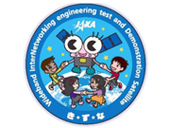 |
| KIZUNA Logo |
|
Oct. 10, 2007 Updated
"KIZUNA" chosen as nickname for "WINDS"!
The Wideband InterNetworking engineering Test and Demonstration Satellite (WINDS) is a super-high speed Internet satellite scheduled to be launched in the coming Winter launch season.
As a result of asking the public to nominate a nickname for it, 9,657 suggestions were received in total. Among them, "KIZUNA," meaning "ties" or "bonds," was chosen after 452 nominations for it were received, indicating the strong hope for the satellite to play the role of bonding people.
The "KIZUNA" is now undergoing its final verification test at the Tsukuba Space Center. Its launch operations will start in early November at the Tanegasima Space Center.
|
|
Sep. 4, 2007 Updated
Thermal vacuum test of the Multi-Beam Antenna (MBA)
A thermal vacuum test was held for the MBA.
The test was to verify the electric function and thermal design by exposing the MBA to high and low temperatures in a vacuum environment.
The conditions for the MBA in transfer orbit and geostationary orbit were respectively simulated, and two tests, one with the main reflectors stowed and the other with them deployed, were performed.
After the environment test, the MBA will be tested for antenna pattern measurements.
|
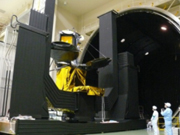 |
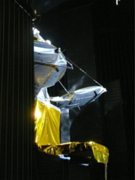 |
Photo A
(Moving into the space chamber with
the main reflectors deployed) |
Photo B
(Verification with
solar light irradiation) |
|
Aug. 3, 2007 Updated
The WINDS satellite system completed acoustic and vibration tests without any trouble.
A mechanical environmental test was performed on WINDS at a test facility at the Tsukuba Space Center.
Mechanical environmental tests aim to confirm the electrical function and performance of the satellite structure and on-board equipment under an acoustic and vibration environment during the rocket launch. The satellite was shaken hard both vertically and horizontally and after obtaining the acceleration data we confirmed that WINDS could perform as designed and has no problems.
We also performed a hold and release shock test on the main reflector of the Multi Beam Antenna (MBA) using gunpowder to deploy the antenna and confirmed it could fully withstand the shock at deployment.
WINDS during the acoustic test exposed to heavy noise at the rocket launch. (Photo 1)
WINDS during the sine?wave vibration test. The Solar Array Paddle is at the front and the stand underneath is the vibrator. (Photo 2)
The hold and release shock test on the main reflector of the MBA. We confirmed that the holding part is released and the reflector starts to open. (Photo 3)
|
|
Jun. 27, 2007 Updated
WINDS shown to the media at Tsukuba Space Center
On June 26, 2007, the wideband internetworking engineering test and demonstration satellite (WINDS) was previewed to the media at the Tsukuba Space Center. WINDS has finally reached its last preparation stage ahead of its launch in winter this fiscal year.
|
|
May 31, 2007 Updated
RF Emission Test performed on WINDS Satellite System
We have performed a Radio Frequency (RF) emission test on the main body (system) of the Wideband InterNetworking engineering test and Demonstration Satellite (WINDS), which carries the Multi Beam Antenna (MBA) and the Active Phased Array Antenna (APAA), in the radio frequency test building at the Tsukuba Space Center. The satellite system storing the MBA and APAA onboard measures about 8 meters long and looks like a tower.
The RF emission test aims to confirm that the radio frequency is being properly transmitted and there is no radio frequency interference inside the satellite by imitating the satellite’s on-orbit transceiver condition for radio frequencies.
This test has confirmed the expected performance and there is no influence on bus-related systems.
At the moment, WINDS is preparing for a mechanical environment test ahead of the launch in the winter of FY 2007. Please look forward to its launch.
|
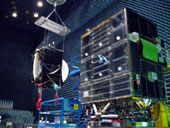 |
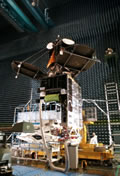 |
Assembly operations for the
Multi Beam Antenna (MBA) |
WINDS Satellite System
A scene from the
RF emission test |
|
May 31, 2007 Updated
Proto Flight Test (PFT) performed on WINDS Solar Array Paddles
We have performed various tests on the Solar Array Paddles of the WINDS.
The Solar Array Paddles are important devices to provide electricity to the satellite by converting solar energy into electric energy in the void of space after the satellite has been launched.
As part of the Proto Flight Test (PFT), various tests including a deployment shock test, a vibration test, an acoustic test and an electric performance test were performed.
Through these tests, we confirmed that the Solar Array Paddles will resist shocks from priming materials and can be deployed normally, and there is no problem with its electric performance.
At the moment, the Solar Array Paddles are attached to the satellite system to perform a mechanical environment test on the WINDS.
|
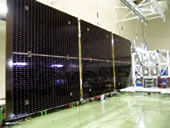 |
WINDS Solar Array Paddles
A scene from the
deployment test |
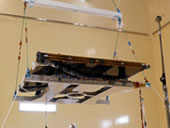 |
WINDS Solar Array Paddles
A scene from the acoustic test |
|
Feb. 28, 2007 Updated
Proto Flight Test (PFT) for the multi beam antenna (MBA) and satellite system
In the past, we had to manufacture both a proto model (test model) and a flight model for the development of a satellite, but thanks to the improved reliability of materials and parts, we now need to make only a "proto flight model (PFM)" for tests and launches.
The final hurdle before launch is the "proto flight test (PFT)" of the PFM.
In December, 2006, the PFM of the multi beam antenna (MBA) onboard the WINDS (Wideband InterNetworking engineering test and Demonstration Satellite) was completed, and the PFT of the MBA started. The test is being carried out smoothly as follows.
| Main reflector deployment test |
to verify the firm on-orbit deployment of the main reflector (Dec. 2006, Photo A) |
|---|
| Sinusoidal vibration test |
to verify that the MBA can survive in the launch vibration environment. Up to 100 G acceleration was applied on the MBA. (Jan. 2007, Photo B) |
|---|
Pyro-shock test for the
release mechanism of the
main reflector |
to verify if the MBA is strong enough after firing pyrotechnics to deploy the antenna in orbit. A big shock (about 3,500 G acceleration) was applied to the MBA for an instant in a man-made space environment. (Jan. 2007, Photo C) Photo D shows the moment of the antenna release taken by a high speed camera. |
|---|
The assembly of the PFM of the satellite system (WINDS system) was also completed, and its PFT has also started. (Photo E on Jan. 2007 at the Keihin Plant of NEC TOSHIBA Space Systems, Ltd.)
The satellite system PFT aims at verifying the normal operation of the onboard mission equipment and the satellite bus of the WINDS in all phases starting from launch to the on-orbit operational phase. The PFT starts with the "initial electric performance test" followed by the "heat balance/thermal vacuum tests," "RF emission test," and "mechanical environmental test."
After going through the series of tests, WINDS is scheduled to be transported to Tanegashima at the end of Oct. 2007 for launch site operations. (Photo F: WINDS system in the vacuum chamber at the Tsukuba Space Center.)
|
|
Jul. 24, 2006 Updated
Protoflight test (PFT) for the KA band multi-port amplifier (MPA) underway
The multi-port amplifier (MPA) for the Ka band (18GHz) aboard the WINDS is about to achieve its basic required performance for the mission after completing the evaluation testing of its breadboard model (BBM) and system electric model. As the flight model is being assembled, it is currently undergoing a protoflight test (PFT).
The MPA operates eight traveling wave tube amplifiers (TWTAs) simultaneously to compose all outputs electrically. The TWTA is a device that generates high heat, thus the temperature increases up to 60 degrees (C) during operation. On the other hand, it is important to control the temperature difference among eight TWTAs as equal as possible (within about 10 degrees (C) difference.)
In space, each TWTA is in an insulated environment through vacuum, like being in a Thermos, and it is difficult to control the temperature. Therefore, a heat pipe is installed underneath each TWTA to minimize the temperature difference among the eight tubes.
One of the purposes of the PFT is to verify if this effort works. In the PFT, we will set the temperature of the vacuum chamber to various degrees, about -10 degrees, +23 degrees, and +50 degrees (C), to check if the MPA performs normally in the harsh space environment.
For previous articles about the MPA (back numbers) please check the following:
June 9, 2003: Challenge of the WINDS (1) Multi-port amplifier
April 6, 2005: Verification by the system engineering model (SEM)
|
|
Dec. 20, 2005 Updated
Electric model test of multi-beam antenna
The electric model (EM) test of the multi-beam antenna (MBA) was held at the radio test building at the Tsukuba Space Center.
The MBA will radiate beams (radio waves) and provide super high speed communications of up to 1.2Gbps to many places in Japan and 19 regions in East Asia and Pacific countries. During the EM pattern test of the MBA, we took time to check each beam performance of the MBA.
The test results were positive, and verified that the MBA has sufficient performance capabilities.
|
 |
| Electric model test of the multi-beam antenna |
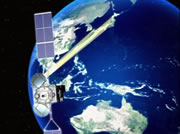 |
| Multi-beam antenna in orbit (image) |
|
Aug. 8, 2005 Updated
Test for measuring thermal distortion of multi-beam antenna
Test for measuring thermal distortion of multi-beam antenna
The WINDS project carried out a distortion measurement test in a 13-meter diameter space chamber (vacuum chamber) at the Tsukuba Space Center. The test was epoch-making as it used photo measurement technology in the vacuum chamber during the development phase of the satellite.
The test enables us to measure the thermal distortion of the antenna in the cryogenic vacuum environment. Also, by using the measured data, we can accurately predict the thermal distortion and communication performance of the communication system in space, which is also cryogenic vacuum environment.
The test showed good results, and the acquired data will be incorporated into the detailed design of the multi-beam antenna of the WINDS.
|
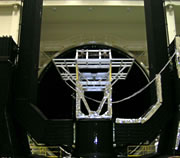 |
| Antenna thermal distortion test |
 |
| Antenna under photo measurement |
|
Jun. 30, 2005 Updated
Heat balance test for structural thermal model (STM) of multi-beam antenna (MBA)
A heat balance test was held for the structural thermal model (STM) of the multi-beam antenna (MBA) in a 13-meter diameter space chamber at the Tsukuba Space Center.
The test on the antenna stowed MBA simulated the thermal environment of the transfer orbit to predict the MBA? thermal condition before it arrives at its geostationary orbit. The MBA with a deployed antenna was tested under a thermal environment of a geostationary orbit for checking the thermal condition of the MBA after its arrival and during operations there.
|
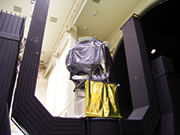 |
| Heat balance test with the antenna stowed MBA. |
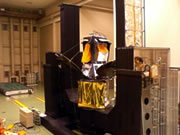 |
| Heat balance test with the antenna deployed MBA. |
|
Apr. 6, 2005 Updated
Verification by the system engineering model (SEM)
The WINDS project team has been carrying out tests on the system engineering model (SEM) in parallel with tests on the structural thermal model (STM) since mid-June, 2004. The SEM is a model for verifying the electric and communication system design that checks the following:
(1) Verifying the electric design of the WINDS communication system and its network control.
Normal operation as a satellite system is verified by combining the communication components with the SEM. Then a comprehensive function as one communication system is verified by combining an "experimental user station" of a ultra-small earth station (USAT) that has an 45 cm-diameter antenna and a prototype of a "base station" that is an earth station which controls and manages the network with the SEM.
(2) Verifying the stable power supply.
Voltage fluctuation is checked when the heavy loads of the mission subsystems are powered up.
In April 2005, we plan to carry out a "mission integration test" with all communication system components (except antennas) and a "compatibility test" with the components and the prototypes of user stations and earth stations to verify the high-speed switching function of the WINDS communication system.
The photo shows the SEM-MPA (Multi-port amplifier) combination test. Using the MPA, which is a high-output power transmitter with eight input/output systems, power output can be controlled when radio frequency of the satellite downlink is attenuated due to rain.
|
|
Nov. 18, 2004 Updated
Satellite Tests start at SITE
A test using a satellite thermal model (STM) of WINDS started at the Spacecraft Integration and Test Building (SITE) at the Tsukuba Space Center in Oct. 2004.
In the first phase, we are performing a structure test to verify if the satellite can survive in a vibrant environment at the time of liftoff and if the vibration conditions of the onboard equipment are within design specifications. We currently are performing a “sinusoidal vibration test”, an “acoustic test” and a “shock test” for the STM of the satellite system.
A “heat balance test” is scheduled next. In that test, the thermal environment in a Geostationary Orbit, which is the WINDS’s target orbit, is simulated in a 13-meter diameter space chamber to verify if the internal temperature of the STM of the satellite system can be controlled within the range of the design temperature.
Photo 1: The STM of the satellite system being prepared for the test
A unit structure test using the STM of the onboard Multi Beam Antenna (MBA) also started in October. The STM of another antenna for the onboard equipment, the Active Phased Array Antenna (APAA), will be tested next, and these antennas will be installed in the STM of the satellite system after their unit tests are completed before moving onto the comprehensive structure test.
We will inform you of the progress of the test.
Photo 2: The STM of the MBA on the vibration test stand.
|
|
Aug. 18, 2004 Updated
Computer Graphic Movies
Details of the Wideband Internetworking Engineering Test and Demonstration Satellite (WINDS) project using computer graphics have been published. Three computer graphics including "Information about Each Mission Equipment" were released this time. To view the computer graphics, please click the titles in the "Image and Movie" section on the right. The aim of the WINDS project is to develop and verify necessary technologies for ultra-high speed and broader coverage communications.
|
|
Nov. 28, 2003 Updated
The heat balance test of the Active Phased Array Antenna is completed.
The transmitter of the Active Phased Array Antenna (APAA) consists of 128 elements, which are tightly packed in line. Each element is a monolithic structure composed of a small aperture antenna and a solid stage power amplifier.
The elements will be exposed to harsh temperature changes in space, but, at the same time, they will generate heat by themselves. For the best performance in orbit, it is important to make the temperature condition of all 128 elements even, because the APAA works most efficiently when the characteristics of all the elements are consistent.
The purpose of the heat balance test is to verify the temperature fluctuation of the elements is kept within a designed range. The test was held in a space chamber at the Tsukuba Space Center by simulating low and high thermal conditions and high vacuum space environment. A structural and thermal model was used for the test, and the acquired data will be incorporated into the thermal design of the flight model.
Photo : Being ready for the heat balance test in the 6m-diameter radiometer space chamber
|
|
Jul. 15, 2003 Updated
Challenge of WINDS (2) Active Phased Array Antenna
WINDS is equipped with the Active Phased Array Antenna (APAA), which can flexibly establish communication to cope with a demand of a certain area by scanning with electronic beams. The APAA of Ka-band, which forms sharp beams, is expected to be advanced antenna technology to enable high speed transmission.
For making the antenna compact, the Monolithic Microwave IC is actively applied to elements of the amplifier and phase shifter. The Monolithic Microwave IC is a product of merging semi-conductor and microwave circuit technologies.
We are currently manufacturing a model for ground tests and implementing some tests to move onto the development phase of the flight model.
Figure :
APAA for transmitting (Upper) and receiving (Lower). Each of them has 128 elements of pyramid-shaped horns. Beam directions can becontrolled by maneuvering a phase of each element.
|
|
Jun. 9, 2003 Updated
Challenge of WINDS (1) Multi-port Amplifier
WINDS will be equipped with a multi-beam antenna to establish fixed communication lines with multiple locations, and more efficient operation is possible by using the antenna with a multi-port amplifier that enables to make various combinations of plural beams and plural amplifiers dynamically.
The WINDS onboard multi-port amplifier with eight ports can flexibly shift the allocation of power supply to each beam according to changing factors such as local communication demand fluctuation or attenuation due to weather conditions like raining. With this function, limited transmission power can be utilized more efficiently.
Therefore, in addition to the basic performance as an amplifier, it is also important for the multi-port amplifier to be designed to efficiently compose multiple outputs. The breadboard model (BBM) evaluation tests to date indicate that that technical challenge has been mostly overcome.
The WINDS project is now moving on to develop and verify the ground test and flight models.
NASDA REPORT No.129 [2003/03]
( Photo )
Multi-port amplifier BBM
Total maximum output power reaches more than 280 watts with 10 traveling wave tube amplifiers (including two backups).
Amplifier block diagram
Eight varied input level signals are allocated, amplified, composed and transmitted to eight output lines.
|
|
